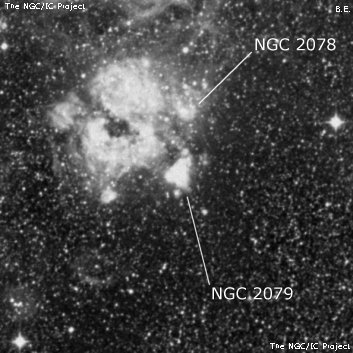
NGC 2079 is collinear with two mag 12 stars 1.7' N (at the center of 2078) and another mag 12 star 3.5' N. The main section of the complex to the northeast forms a large "S" shaped group of multiple knots with NGC 2078 1.7' N, 2084 to the east and 2083 to the NE.
John Herschel discovered NGC 2079 = h2949 on 23 Dec 1834 and recorded "The most southern of a group of 4 or 5 nebulae, 5' diameter, mixed with stars. This is the south preceding of the four chief nuclei NGC 2078, 2079, 2083 and 2084] of the complex group of Plate III, figure 4". Herschel's sketch shows a complex object with 7 condensations or nuclei involved in nebulosity with the NGC 2079 at the upper right corner in the detailed sketch.
James Dunlop discovered the entire complex earlier in 1826 and described D 152 as "a cluster of six or seven small nebulae, forming a square figure 5' or 6' diameter, with several minute stars mixt. This is a very pretty group of nebulae - see Figure 5." Dunlop's sketch with 6 or 7 patches within a group of stars appears to show this complex though his position is offset 15' too far SE. Since NGC 2079 is one of the brightest sections, Dunlop should probably be credited with the discovery.
Annie Jump Canon established the emission spectrum of NGC 2079 in 1897 during her spectroscopic survey at Arequipa for the Henry Draper catalogue. It was independently found by Delisle Stewart around the same time.
600/800mm - 24" (4/9/08 - Magellan Observatory, Australia): this is the brightest section of an impressive 4' collection of perhaps 8 different emission knots (collectively LMC-N159) that are encased in a diffuse glow and carry four separate NGC designations. NGC 2079 (LMC-N159A) is situated on the southwest end of the complex and appeared extremely bright, ~1' diameter,with a uniform very high surface brightness. The outline has an unusual triangular shape (one vertex at the north end) with a well-defined border and appears detached from the main section. Without a filter, a faint star and ionizing source (DD 13, an unresolved pair of O-stars) is located at the center of the glow.
Notes by Steve Gottlieb